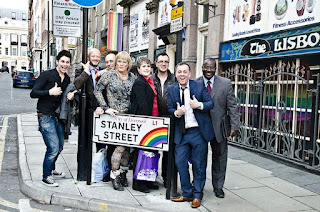History of Gay Liverpool leading up to Gay Pride
by , 08-06-2012 at 12:17 AM (7768 Views)
In keeping with Liverpool's history as a major seafaring port, the local gay community can be traced as far back as the Victorian era. Whilst in the past research into this area has been limited and scarce, interest has grown considerably in recent times.
In his 2011 lecture ‘Policing Sex Between Men: 1850-1971’, historian Jeff Evans examined 70,000 criminal records dating back to 1850 and was able to shed light on hundreds of records of men prosecuted under the Criminal Law Amendment Act 1885 (the law used to prosecute Oscar Wilde) found in the court papers of Liverpool and North West England.
The legacy of Victorian laws and homosexual criminalisation meant that the city's lesbian and gay community would be largely underground for the next century and little is known about it during this period. However, recent research has highlighted the existence of an unofficial gay quarter around Queen Square from as early as the 1940s, which earned itself the nickname "Covent Garden of the North".
Although gay sex between consenting adults was not legalised until 1967, the gay community enjoyed relative acceptance in this area and establishments such as the Stork Hotel, the Roebuck, Spanish House, Magic Clock, Royal Court, and The Dart all boasted a substantial gay clientele, albeit liaisons were still held in secret to a degree. By the early 1970s, a gay society named ‘The Homophile Society’, which campaigned for homosexual equality, was formed at the University of Liverpool.
Queen Square to Stanley Street
The building of the new St. John's Shopping Centre and subsequent demolition of the original Queen Square meant the gay community was forced to find a new home and by 1972, with the opening of Paco’s, in Stanley Street by Gordon Shearer the owner of the Bears Paw night club, the community began to settle around Stanley Street area which was to develop into Liverpool’s modern day Gay Quarter.
As part of the first phase of redevelopment, Liverpool became the first city in the UK to install street signage bearing the rainbow coloured Gay Pride flag on 11 November 2011. The signage identifies the city's Gay Quarter located on Stanley Street, Cumberland Street, Temple Lane, Eberle Street and Temple Street.
Plans to revamp Liverpool’s gay quarter were unveiled in February 2011. City leaders believe a vibrant gay village around Stanley Street is key to the future economic success of Liverpool city centre as an international tourist destination. Urban planner Feria Urbanism carried out a £12,000 study in conjunction with the City Council to formulate a vision for the gay quarter to put it on a par with the best in the UK. The company is consulting with businesses and residents in the area to see how public areas and safety can be improved. It is hoped a fresh marketing strategy can also be formulated.
August 2012 saw the third Gay Pride celebrations take place in the city with large numbers of people attending events both at the Pier Head and in the Gay Quarter. A large stage was erected on Dale Street facing Stanley Street and another at Eberle Street. The Masquerade Bar provided an outside Bar for customers and entertainment in the venue continued for the entire day.
Photographs of this years Pride and links at http://www.liverpoolpicturebook.com/...ing-up-to.html
- Categories
- Uncategorized












